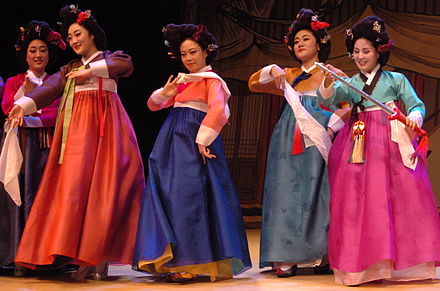Gache
| Gache | |
 | |
| Korean name | |
|---|---|
| Hangul | 가체 |
| Hanja | 加髢 |
| Revised Romanization | gache |
| McCune–Reischauer | kach'e |
The gache (Korean: 가체; Hanja: 加髢) is a traditional Korean wig worn by women. Historically, gache were expensive accessories worn only by women of high social standing, alongside kisaeng. They were decorated with silk objects, gold, jewels, silver, coral, jade, and other expensive materials. Certain decorations were reserved for royalty.
History
Historically, women of high social backgrounds and kisaeng wore gache, with larger and heavier wigs considered to be more aesthetically pleasing. Due to the expense of purchasing a new gache, some lower-class families took up to 6–7 years preparing a new gache wig for their new daughter-in-law.[1]
Use of the gache flourished in Goryeo, the Three Kingdoms, Balhae, the Gaya confederacy, and Gojoseon. Gache became so popular that in 1788, King Jeongjo of Joseon prohibited and banned by royal decree the use of gache, as they were deemed contrary to Confucian values of reserve and restraint.[2]
In the 19th century, yangban women began to wear the jokduri, a small hat that substituted for the gache. However, gache still enjoyed vast popularity in kisaeng circles and traditional weddings.
Gache were known for their relatively heavy weight, totalling around 3–4 kilograms (6.6–8.8 lb) with accessories; one record reports an incident where a heavy gache wig led to the death of a 13-year-old bride, as the heavy wig compromised her neck as she was getting up to greet her father-in-law entering the room.
Gallery
-
Empress Sunjeong of the Korean Empire, 1909
-
Modern representation
-
18th-century illustration of a gache
-
Illustration from the late 18th-century
See also
References
- ^ Korean: 무거운 '가체' 때문에 사망한 사람이 있다! http://kdaq.empas.com/knowhow/view.html?num=451347l
- ^ The Traditional Art of Beauty and Perfume in Ancient Korea by Guest Contributor Pauline http://www.mimifroufrou.com/scentedsalamander/2008/04/beauty_perfume_in_traditional.html
External links
- (in Korean) Brief information about gache



